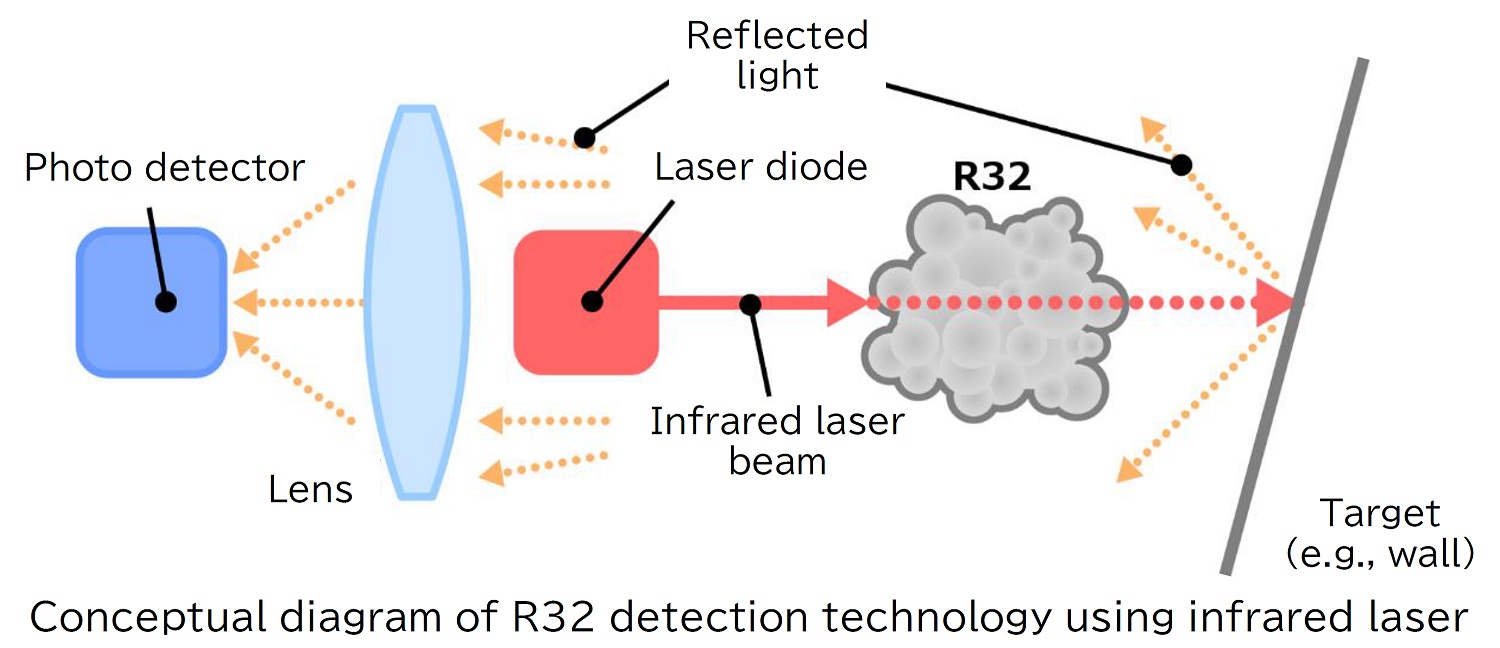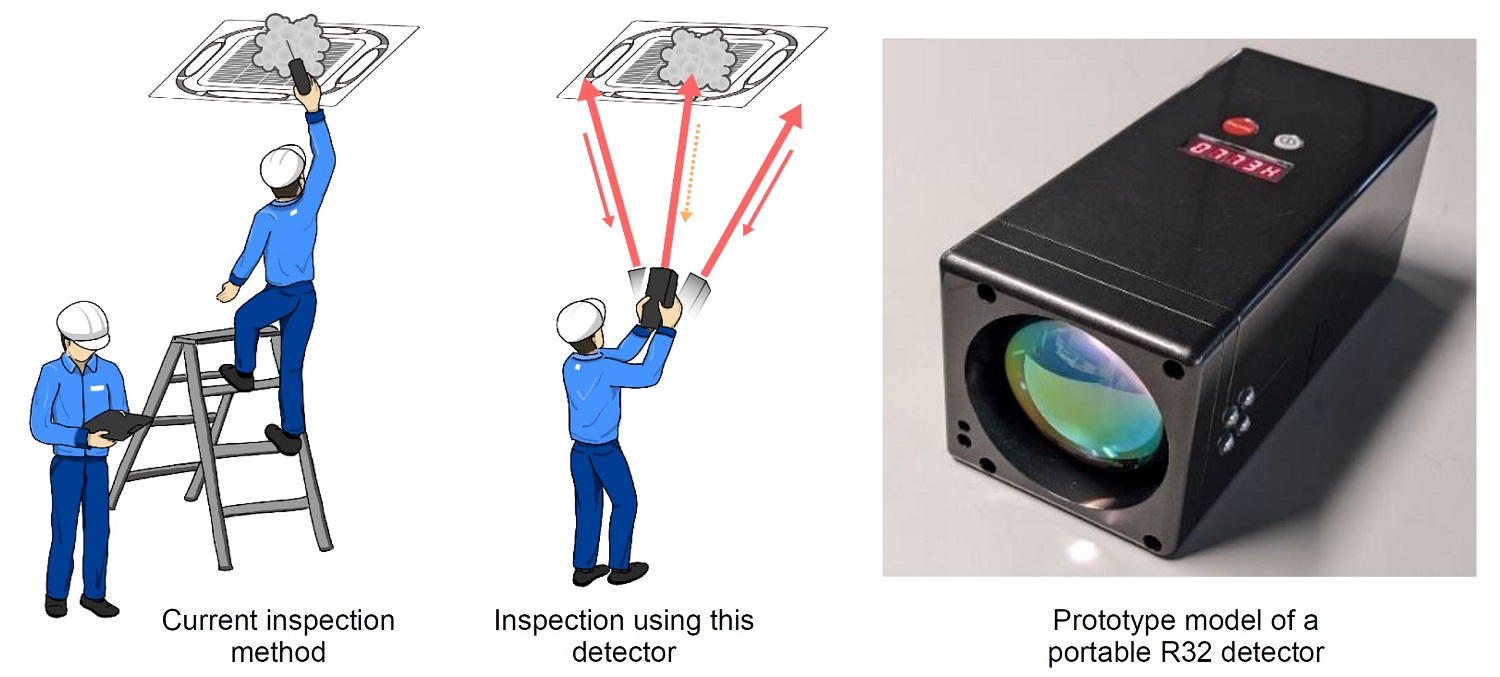Press Releases
To contribute to further reduction of greenhouse gas emissions by improving refrigerant leak detection during on-site inspection of air conditioners
Daikin Industries, Ltd.
Tokyo Gas Engineering Solutions Corporation
RIKEN National Research and Development Agency
Daikin Industries, Ltd. (President & CEO: Masanori Togawa), Tokyo Gas Engineering Solutions Corporation (TGES, President & CEO: Yasuhiro Konishi), and RIKEN National Research and Development Agency (RIKEN, President: Makoto Gonokami) announces the development of the world’s first laser-based technology that remotely detects leaks of HFC-32 (R32) refrigerant. Additionally, Daikin and TGES have jointly collaborated on a prototype for a portable R32 detector that incorporates this technology and demonstrates the capability to remotely detect R32 up to 10 meters away. In the future, the two companies are looking to further boost detection sensitivity of this device and conduct on-site testing in 2024 with the aim for commercialization in 2025.
Air conditioners contain an enclosed gas called refrigerant that is essential for the heating and cooling of air, and hydrofluorocarbons (HFC) are the most commonly used substance for refrigerants. However, in recent years, the global warming effect generated by refrigerant leaks has become an international issue, creating an urgent need to reduce the global warming potential (GWP) of refrigerants and institute measures to prevent leaks. To this end, Japan has taken the global lead in conversion to R32, a low GWP refrigerant with one-third of the GWP of HFC-410A (R410A) ※1, the main refrigerant used prior to 2012. Since reaching nearly 100% adoption in all residential air conditioners manufactured and sold in Japan, R32 has gained worldwide recognition as a low GWP refrigerant and is currently used in more than 130 countries. With greater global attention being focused on R32 refrigerant leaks, three parties hope to help curtail greenhouse gas emissions through the practical application of this technology and utilize its capability to accurately and efficiently detect R32 leaks.
Currently, on-site inspections for air conditioner refrigerant leaks typically employ an air sampling method※2 in which after sales service personnel carry the inspection equipment to areas of suspected leakage points to take and evaluate air samples. Because air conditioners and piping are often installed in high places, such as ceilings, requiring a stepladder or are located in narrow spaces that are difficult for after sales service personnel to enter, considerable time and effort are often required for leak inspections. Worker safety may also be a concern, and getting inspection equipment near the air conditioner may be extremely difficult. However, by aiming a laser from a distance and irradiating the path in the vicinity of the targeted object, this newly developed portable detector can efficiently confirm the presence of a R32 leak. Compared to conventional air sampling methods, this is expected to significantly reduce work hours and improve safety while ensuring a prompt countermeasure.
Moreover, this technology and detector can detect refrigerant blends that contain R32, including the previously mainstream refrigerant R410A. In addition to detecting refrigerant leaks from equipment in use, this detector can also be used in various other situations within the circular economy of refrigerants, such as detecting leaks from discarded equipment and monitoring leaks at refrigerant reclamation plants, to curb greenhouse gas emissions even further. In the future, three parties will aim to contribute to a sustainable society through implementation of this technology and detector.
Technological results will be presented at the International Symposium on New Refrigerants and Environmental Technology 2023. The symposium is sponsored by the Japan Refrigeration and Air Conditioning Industry Association (JRAIA) and is being held at the Kobe International Conference Center from November 16th to November 17th. An actual detector unit will be exhibited and announced.
This detector emits an infrared laser with a wavelength corresponding to the near-infrared absorption wavelength band unique to R32 that was jointly identified by RIKEN and Daikin※3and uses a lens to collect light that is diffusely reflected from walls. It applies the high-sensitivity detection technology used in TGES’s remote detector for detecting methane※4, the main component of natural gas, and adapts it for R32 to measure the attenuation of reflected light that occurs when R32 is present in the laser beam path. Detection is possible up to a distance of approximately 10 meters and through windows.

Current air sampling inspection methods in use require constantly moving a stepladder to individually check potential leakage points for multiple indoor air conditioner units. Because this detector can efficiently detect from a distance, a significant reduction in required work hours and improved safety are expected along with prompt execution of countermeasures.

Because of the increasing worldwide popularity of R32, countermeasures for preventing leaks have become increasingly more important. RIKEN, which has optical remote gas detection technology using lasers, and Daikin, which has know-how in refrigerant leak countermeasures, began development of technology that could efficiently detect R32 in the air by using lasers and succeeded in identifying the near-infrared absorption wavelength band unique to R32 that is necessary for this technology. From there, Daikin collaborated with TGES, which in 2001 commercialized the world's first remote methane detector using a laser, to apply unique sensitivity enhancement technology and create a prototype model for a hand-held, portable R32 detector. Daikin and RIKEN worked to develop equipment that can emit lasers at highly accurate wavelengths and detect wavelengths with high sensitivity that correspond to a specified wavelength.
This initiative is based on the premise that R32 (CH2F2) could also be detected with a laser since R32 has a structure similar to methane (CH4), and methane has the property of strongly absorbing near-infrared rays at a specific wavelength. Three parties have been involved in conducting demonstrations for this collaborative creation activity. Going forward, Daikin and TGES will work to further improve detection sensitivity and reduce the size of the detector so that it can easily be utilized on-site. Commercialization of this detector is planned for some time in 2025.
| Items | Details |
|---|---|
| Gas to be detected | R32 |
| Detection level | 1~50,000ppm-m |
| Detection accuracy | ±10% @100-1,000ppm-m |
| Detection speed | 0.1 sec |
| Detection distance | Up to 10 m |
| Power supply | Dedicated battery |
| Laser safety class | Guide light(red): Class 2, Measuring light(infrared): Class 1 |
| Operating temperature range | -17℃ to 50℃ |
| Dimensions | 150(W)× 300(D)× 150(H)mm |
| Weight | 500 g |
Find out more in your region.